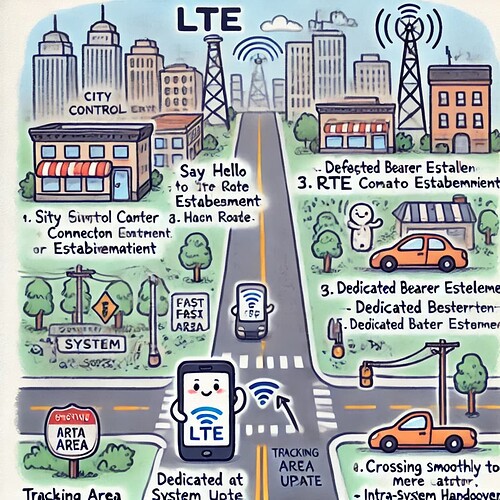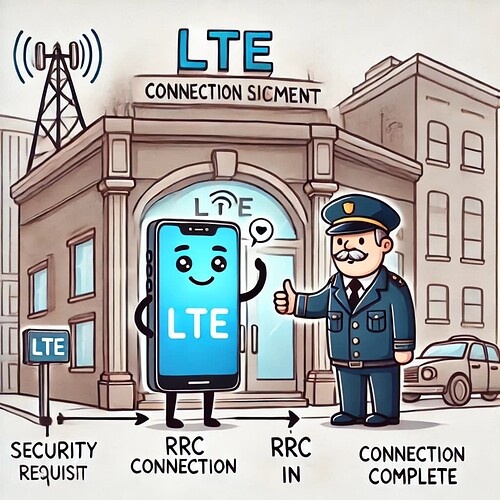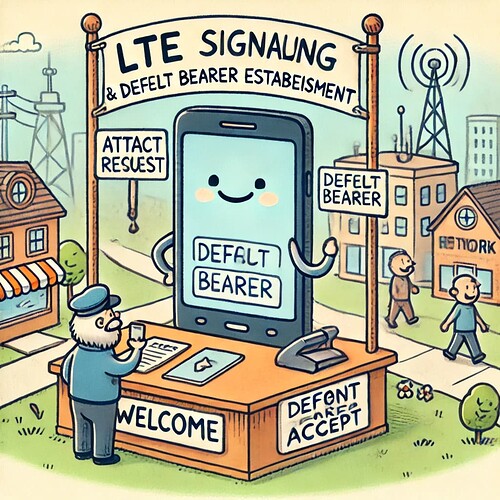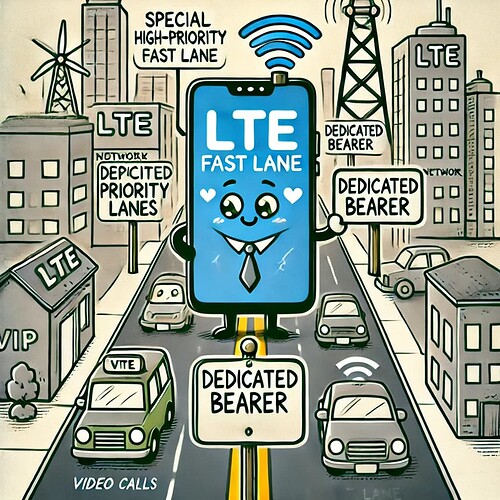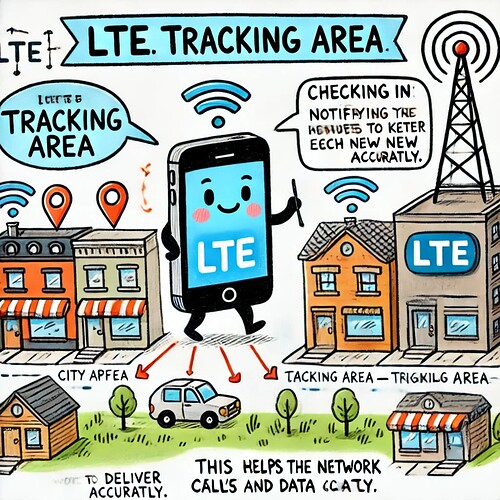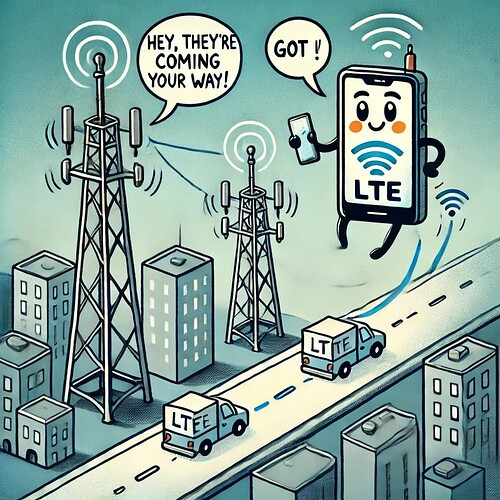This topic presents in a very simplified way all the main concepts that should be understood by those who know LTE.
LTE Signaling Procedures
LTE signaling procedures are the steps that help your phone connect to the network, update its location, and maintain a reliable data connection. Each of these procedures follows a structured call flow that keeps your phone connected to the network while managing registration, movement, and service quality. This series of messages between the phone and the network ensures that connections are efficient, reliable, and adaptable as you move through different areas and use various services. First, the phone establishes an initial connection to the network, allowing communication to begin. Then, a basic data path, called the “default bearer,” is set up to manage everyday data needs. For more demanding tasks, like high-speed data transfers, an additional, faster data path (or “dedicated bearer”) can be created. As you move around, your phone frequently updates its location to stay visible to the network, and when changing network areas, it smoothly transfers the connection to avoid any interruptions. Together, these procedures ensure your phone remains connected, accurately located, and ready for continuous data access.
![]() Imagine LTE as a big city where your phone follows some simple steps to stay connected. First, it “says hello” to the network, letting the city know it’s there. Then, the city sets up a basic path, like a main road, that your phone can use to get around. If it needs a faster lane for something like watching videos, the network sets up a special route just for that. As you move through the city, your phone tells the network where it is, so the network always knows its location. And if you move into a new area, your phone switches over smoothly to the new network without you noticing. With these steps, your phone stays connected, knows where it is, and has access to all the data it needs!
Imagine LTE as a big city where your phone follows some simple steps to stay connected. First, it “says hello” to the network, letting the city know it’s there. Then, the city sets up a basic path, like a main road, that your phone can use to get around. If it needs a faster lane for something like watching videos, the network sets up a special route just for that. As you move through the city, your phone tells the network where it is, so the network always knows its location. And if you move into a new area, your phone switches over smoothly to the new network without you noticing. With these steps, your phone stays connected, knows where it is, and has access to all the data it needs!
Skip to: Roadmap to LTE
- RRC Connection Establishment
- Attach and Default Bearer Establishment
- Dedicated Bearer Establishment
- Tracking Area Update
- Intra-System Handover
RRC Connection Establishment
RRC (Radio Resource Control) Connection Establishment is the first step when your phone wants to connect to the LTE network (initially sets up a stable link with the network). In the call flow, the phone (User Equipment or UE) sends an RRC Connection Request message to the network to start the connection process. The network responds with an RRC Connection Setup message, allowing the UE to set up initial parameters for communication. After setting up, the phone sends an RRC Connection Complete message back to the network. This three-step handshake confirms that the connection is ready, allowing data exchange to begin.
![]() RRC Connection Establishment is like your phone shaking hands with the network to start a conversation (connection). It’s like when you walk into a building and check in with security. By doing this, your phone and the network agree that they’re ready to talk and exchange data. First, it waves to get noticed (RRC Connection Request), and the group leader (the network) nods back, saying, “Come on in” (RRC Connection Setup). Once inside, your phone gives a thumbs-up (RRC Connection Complete) to confirm it’s ready to chat and stay connected. This process makes sure your phone is ready to talk with the network whenever you need.
RRC Connection Establishment is like your phone shaking hands with the network to start a conversation (connection). It’s like when you walk into a building and check in with security. By doing this, your phone and the network agree that they’re ready to talk and exchange data. First, it waves to get noticed (RRC Connection Request), and the group leader (the network) nods back, saying, “Come on in” (RRC Connection Setup). Once inside, your phone gives a thumbs-up (RRC Connection Complete) to confirm it’s ready to chat and stay connected. This process makes sure your phone is ready to talk with the network whenever you need.
- Search Forum
 LTE RRC Connection Establishment
LTE RRC Connection Establishment 
Attach and Default Bearer Establishment
Attach and Default Bearer Establishment: Once the RRC connection is established (your phone has established a basic connection with the network, now it needs a pathway for regular data), the next step is for the phone to register with the network through the Attach procedure. This step creates a basic data link, or “bearer,” giving you essential internet connectivity to send and receive data for common activities, like browsing or using apps. The UE sends an Attach Request to the core network, typically the MME (Mobility Management Entity), which then verifies the phone’s identity and capabilities. The network responds with an Attach Accept message, establishing a basic pathway (the “default bearer”) that enables basic internet access. This default bearer (when your phone attaches to the network) allows initial data services, such as basic browsing and messaging, to start immediately after the attachment process.
![]() After shaking hands, your phone needs a basic path to start using the internet, kind of like getting a pass to walk around the city (Once your phone is “in the group,” it needs to register as a member). This is like your phone going up to the welcome desk (Attach Request) and giving its name. The desk checks its info and confirms it’s allowed in with a pass (Attach Accept), setting up a basic “pathway” that lets your phone do simple things like sending texts and browsing the web. This pathway is like a small street in the city that’s always open for quick, everyday trips. You can also think of this as registering as a new resident and getting your first utility connections, like water and electricity.
After shaking hands, your phone needs a basic path to start using the internet, kind of like getting a pass to walk around the city (Once your phone is “in the group,” it needs to register as a member). This is like your phone going up to the welcome desk (Attach Request) and giving its name. The desk checks its info and confirms it’s allowed in with a pass (Attach Accept), setting up a basic “pathway” that lets your phone do simple things like sending texts and browsing the web. This pathway is like a small street in the city that’s always open for quick, everyday trips. You can also think of this as registering as a new resident and getting your first utility connections, like water and electricity.
- Search Forum
 LTE Attach and Default Bearer Establishment
LTE Attach and Default Bearer Establishment 
Dedicated Bearer Establishment
After setting up the default bearer, the network may set up additional pathways for high-priority data. (When specific applications, such as streaming video or voice calls, require extra data support, a dedicated bearer is needed). In the call flow, if the UE requests a service that needs a dedicated path (like video calling), the network will establish a Dedicated Bearer specifically for that service. This process begins with the network sending a Bearer Resource Command to the UE, defining special settings like higher data priority. Once the UE confirms with a Bearer Resource Modification Request, the dedicated bearer is established, providing a reliable and fast channel for high-demand applications. Once the default bearer is established, a dedicated bearer can be set up for specific types of data. It ensures that certain data, like video calls or online gaming, gets priority and can travel more smoothly and quickly. After setting up the basic connection, a dedicated path is created for specific, important data, like VIP lanes for emergency vehicles.
.
![]() Sometimes, your phone needs a “special lane” for something important, like a video call or watching a movie. Here, it’s like the network setting up a fast, special lane just for your phone’s needs. In this case, the network gives special instructions (Bearer Resource Command), and your phone sets up a new pathway for this high-priority data. This dedicated lane helps with smooth and speedy delivery, just like an express lane that keeps your videos from buffering.
Sometimes, your phone needs a “special lane” for something important, like a video call or watching a movie. Here, it’s like the network setting up a fast, special lane just for your phone’s needs. In this case, the network gives special instructions (Bearer Resource Command), and your phone sets up a new pathway for this high-priority data. This dedicated lane helps with smooth and speedy delivery, just like an express lane that keeps your videos from buffering.
- Search Forum
 LTE Dedicated Bearer Establishment
LTE Dedicated Bearer Establishment 
Tracking Area Update
As you move, your phone updates the network with its location through the Tracking Area Update (TAU) procedure, helping the network know where you are for optimal coverage (keep the network aware of your location within larger areas, making sure calls and messages reach you without delay). The UE initiates this by sending a TAU Request message to the network when it detects a new Tracking Area. The network confirms by sending back a TAU Accept message, keeping your location information up-to-date. This ensures that calls and messages reach you without delay, even as you move between areas. When your phone moves between different areas covered by the network, it sends a tracking area update to let the network know its new location, ensuring you stay connected.
![]() As you move around town, your phone needs to let the network know where it is, so it always gets calls or messages quickly (network need to be able to find you, so keep informing as you move to different parts of town). This keeps your phone reachable for calls and messages without losing connection. This is like your phone checking in at each new neighborhood with a quick hello (TAU Request) when it gets to a new spot. The network waves back (TAU Accept), confirming it knows where your phone is now. This way, you’re easy to find, whether you’re at home or exploring new places. Your phone tells the network where it is now, so you stay connected even as you travel around the city.
As you move around town, your phone needs to let the network know where it is, so it always gets calls or messages quickly (network need to be able to find you, so keep informing as you move to different parts of town). This keeps your phone reachable for calls and messages without losing connection. This is like your phone checking in at each new neighborhood with a quick hello (TAU Request) when it gets to a new spot. The network waves back (TAU Accept), confirming it knows where your phone is now. This way, you’re easy to find, whether you’re at home or exploring new places. Your phone tells the network where it is now, so you stay connected even as you travel around the city.
- Search Forum
 LTE Tracking Area Update
LTE Tracking Area Update 
Intra-System Handover
When the UE moves from one tower’s area to another (moving between different cell towers within the same network), it performs a handover to maintain a stable connection and your connection doesn’t drop. In the call flow, the current cell (serving eNodeB) sends a Handover Request to the new cell, which then prepares to take over the connection. The new cell responds with a Handover Request Acknowledge message, and the UE is instructed to connect to the new cell. Once the UE successfully connects, the old connection is released, ensuring the call or data session continues smoothly without interruption. Intra-system handover is like transferring a call from one cell tower to another without dropping it.
![]() When you’re on the go, your phone might need to switch from one neighborhood’s “tower” to the next to keep a call or video going without interruptions. This is like moving from one side of town to another while still talking on the phone. The current tower calls the next one and says, “Hey, they’re coming your way!” (Handover Request). The new tower nods, saying, “Got it!” (Handover Request Acknowledge), and your phone smoothly switches over, staying connected without missing a beat.
When you’re on the go, your phone might need to switch from one neighborhood’s “tower” to the next to keep a call or video going without interruptions. This is like moving from one side of town to another while still talking on the phone. The current tower calls the next one and says, “Hey, they’re coming your way!” (Handover Request). The new tower nods, saying, “Got it!” (Handover Request Acknowledge), and your phone smoothly switches over, staying connected without missing a beat.
- Search Forum
 LTE Intra-System Handover
LTE Intra-System Handover 
That’s it. ![]()
-
Continue reading: Roadmap to LTE - Voice Services
-
Or back to: Roadmap to LTE
